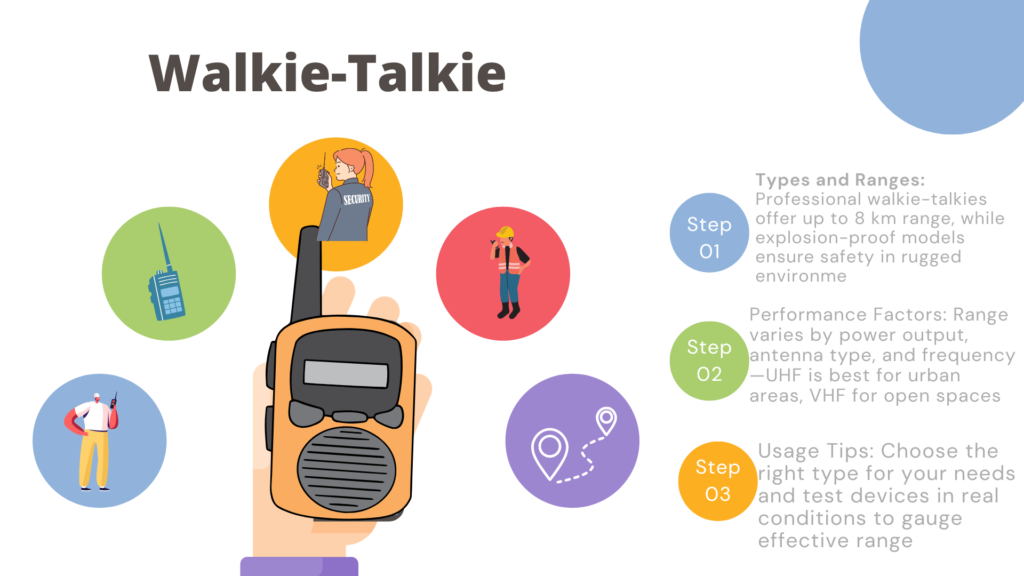What is a Walkie-Talkie?
A walkie-talkie, also known as a handheld transceiver, is a portable two-way radio that allows users to communicate wirelessly. Unlike traditional mobile phones, walkie-talkies operate on specific radio frequencies and use a push-to-talk (PTT) mechanism to initiate communication.
This means that only one person can speak while others listen, making it essential to coordinate when to talk. These devices were first developed in the 1930s and became widely recognized during World War II for military communication.

Walkie-talkies offer several advantages over mobile phones:
- Instant Communication: They provide immediate connection without dialing numbers or waiting for the call to connect.
- Cost-Effective: There are no cellular charges involved, making them economical for businesses and groups.
- Durability: Many models are designed to withstand harsh environments, making them suitable for outdoor activities or industrial use.
- No Signal Issues: They work in areas with poor cellular coverage, ensuring reliable communication when it’s needed most.
How Walkie-Talkie Work
Basic Components
A walkie-talkie consists of several key components:
- Transmitter/Receiver: Firstly, This allows the device to send and receive radio signals.
- Antenna: It facilitates the transmission of radio waves.
- Speaker/Microphone: This component converts sound into radio waves and vice versa.
- Push-to-Talk Button: Users press this button to speak, which temporarily disables the receiver so that only their voice is transmitted.
Operating Mechanism
- Setting the Frequency: All users must tune their devices to the same frequency or channel.
- Initiating Communication: To speak, the user presses the PTT button. This action switches the device from receiving mode to transmitting mode.
- Transmission of Voice: The user’s voice is converted into radio waves and sent out.
- Receiving Communication: The other party’s device picks up these waves and converts them back into sound.
Types of Walkie-Talkie
Different types of walkie-talkies cater to various needs:
- Professional walkie-talkies provide a long communication range of up to 8 kilometers and serve large organizations, such as construction sites..
- Commercial Walkie-Talkies: Lightweight and suitable for events or small businesses, they typically operate over shorter distances (up to 5 kilometers).
- Civilian Walkie-Talkies: Designed for personal use, these are affordable and compact but have a limited range.
- Amateur Walkie-Talkies: Often used by hobbyists or children, they are easy to operate but have short transmission distances.
- Explosion-proof walkie-talkies are designed for rugged environments like mines, preventing sparks and ensuring safety in hazardous conditions
How to Use Motorola Walkie Talkies
Motorola is a well-known brand in the walkie-talkie market. Here’s how you can effectively use their devices:
Step-by-Step Guide
- Charge Device: Ensure walkie-talkies are fully charged before use. Most models come with rechargeable batteries.
- Power On: Turn on your device using the power button. You should hear a beep indicating it’s operational.
- Select a Channel:
- Use the channel selector knob or buttons to choose a common frequency that all users will share.
- Make sure everyone else has their devices tuned to the same channel.
- Adjust Volume: Set the volume level so you can hear clearly without straining.
- Press-to-Talk:
- To speak, press and hold the PTT button.
- Speak clearly into the microphone while keeping your mouth about an inch away from it.
- Release After Speaking: Once you finish your message, release the PTT button to listen for responses.
- Use Call Tones (if available): Some models allow you to send call tones before speaking, which can help get attention.
- Maintain Battery Life:
- Turn off your device when not in use.
- Avoid using unnecessary features that drain battery life quickly.
- Store Properly: Keep your walkie-talkies in a safe place when not in use, preferably in a protective case.
Tips for Effective Communication
- Always say “over” when you finish speaking to indicate that it’s the other person’s turn.
- Keep messages concise; avoid long-winded explanations as they can lead to confusion.
- Be aware of background noise; try to find a quieter environment if possible.
Troubleshooting Common Issues
- Poor Reception:
- Check if all devices are on the same channel.
- Move closer together if possible; obstacles can interfere with signals.
- Battery Problems:
- If your device isn’t powering on, ensure it’s charged properly.
- Replace batteries if they show signs of wear.
- Static Noise:
- Adjust the volume settings or switch channels if interference occurs from other users.
Conclusion
Walkie-talkies remain an essential tool for communication in various fields due to their reliability and ease of use. Whether you’re coordinating a team at work or staying connected with family during outdoor adventures, understanding how to use these devices effectively can enhance your experience significantly.
Following these guidelines on using Motorola walkie-talkies will equip you with seamless communication. Embrace this technology as an efficient alternative to mobile phones, especially in areas where cell service is unreliable, and enjoy clear conversations with those around you!
